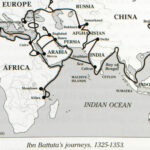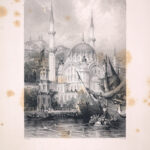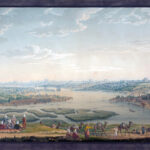Ibn Battuta
Explorer
Medieval
Quick Facts:
He was a Muslim explorer who made a series of journeys that spanned nearly three decades. He traveled throughout almost the entire Islamic world, and went as far as India and China.
Introduction
Abu Abdullah Muhammad Ibn Battuta, better known by his surname Ibn Battuta, was a great Medieval traveler and explorer. He is often compared to Marco Polo, who died a year before Ibn Battuta left home. But unlike Polo, Ibn Battuta traveled mostly to and within Muslim regions. This network of Muslim kingdoms is called the Dar al-Islam, or “Abode of Islam.” His book, or rihla in Arabic, helped shed light on many aspects of the social, cultural, and political history of a great part of the Muslim world.
Biography
Early Life
Abu Abdullah Muhammad Ibn Battuta (known as Ibn Battuta) was born on February 25, 1304 in the city of Tangier, Morocco in Northern Africa. Little is known about his early childhood. But we know much about his travels because he had them written. Several members of his family were legal scholars and judges. Ibn Battuta received a good education because he came from an elite family. Most boys of this time and place would have received a basic education of writing, grammar, and basic math until the age of twelve. Because Ibn Battuta’s family had status, he would also have had an advanced study of the Koran (also spelled Qur’an): the Sacred Book of the Islamic religion.1 Ibn Battuta went on to study law to become a qadi. Qadi are the judges in Islamic society who have control over matters of religion. This is an important area within Islam.
In 1325, at the age of 21, he left his home to make the traditional pilgrimage, or hajj, to the sacred Muslim city of Mecca in Arabia (today called Saudi Arabia). He joined a caravan with about 20,000 other travelers.2 The hajj would expand Ibn Battuta’s education for his office as qadi. During his year and a half journey, he traveled by sea and over land, often through rough deserts and mountains. He visited North Africa, Egypt, Palestine, and Syria. He wrote how the great port in Alexandria Egypt had two harbors – one for Christian merchant ships and one for Muslim ships.3 He met many people along the way and studied with famous scholars from all over the Islamic world. He became a well liked man. He completed his pilgrimage in 1326, and studied in Mecca for many months. But Ibn Battuta had gained a love for travel. In late 1326, he joined a caravan of travelers heading for Mesopotamia (modern Iraq).4 He would spend the next thirty years exploring the lands of Islamic culture.
Voyages
Principal Voyage
Much of Ibn Battuta’s journeys would take him in part by land, but mostly by water. He first left Mecca in in November 1326 and headed toward Mesopotamia (modern day Iraq). The new Mongol ruler declared that instead of Christianity, Islam would be the main religion of the area. The fact that Ibn Battuta could read and speak Arabic quickly made him a popular visitor among the leaders. His first journey took him to Baghdad in Iraq; Persia (modern Iran); and to Tabriz in Azerbaijan. He completed his journey by boat up the Tigris River to Mosul, Iraq, and then went back to Mecca in 1327.5 His entire journey covered more than 4000 miles. Along the way, he mentions the merchants he met, the gardens in Iraq, and riches such as gold and silver offered to him. He did not stay in Mecca long. In 1328, he took a sea voyage down the eastern coast of Africa to Tanzania; then visited Oman and the Persian Gulf before once more returning to Mecca.6
In 1330, Ibn Battuta left Mecca to head to Yemen and then India. His plan was to go to India, and work for the Sultan of Delhi and Indian government.7 The areas traveled would have had him sailing on the Persian Gulf, Arabian Peninsula and the Red Sea. He would also travel by land through Egypt, Syria and to Asia Minor (part of modern day Turkey). From here he crossed the Black Sea to West Central Asia, and then to the Constantinople, capital of the Byzantine Empire. Today, Constantinople is named Istanbul and is the capital city of Turkey. He continued east, until reaching India in September 1333.8 He spent about eight years as qadi for the ruler of India and wrote about his time there. He mentioned that Indians mostly ate rice and green vegetables, that they were religious people, and even how a thief would be put to death for stealing a single nut.9 In 1345, he decided to travel to China. He sailed along the coast of Burma, to the island of Sumatra, and then Guangzhou, China. He then returned to Mecca once more in 1346.
Subsequent Voyages
Ibn Battuta soon headed for home, and arrived in the Moroccan capital of Fez in 1349. The next year he made a brief trip across the Strait of Gibraltar to Granada. His final journey came in 1353 when he traveled by land across the Sahara Desert to the Kingdom of Mali in the West African Sudan.10 He returned to Morocco in 1355 where he would remain. During his thirty years of travel, he explored much of the eastern hemisphere and almost all of the Islamic world. From each place he visited, Ibn Battuta tells of his experiences. He wrote about the people, places, animals, and treasures he saw or was given. Overall, he traveled about 73,000 miles total, and visited about 40 countries.11
Later Years and Death
Ibn Battuta made many journeys in his life. In 1356, the ruler of Morocco asked a young scholar named Ibn Juzayy to write down Ibn Battuta’s explorations. They would work for two years. This book of travel is called a rihla. It means “journey” in Arabic. After completing the book, Ibn Battuta continued his role as judge in a small Moroccan town. He died around 1368 or 1369. His incredible story became very popular, especially among the Islamic world.
Legacy
Ibn Battuta is celebrated as one one of the most famous Muslim explorers in history, and one of the great travelers of all time. His sea voyages and references to shipping show that the Muslims were very much involved in trading, commerce, and maritime activity of the Red Sea, the Arabian Sea, and Indian Ocean. Almost everything we know of his travels is known because he told his story and had it written down later in his life. His rihla offers a unique account on Islamic and medieval history.
Images
- Map illustrating routes and destinations of Ibn Battuta’s journeys between 1325-1353. The Mariners’ Museum G175 B56 2003
- A mosque is an Islamic house of worship. Ibn Battuta visited several mosques on his journeys. The Mariners’ Museum 1950.0227.000001
- Watercolor showing Constantinople, Turkey, one of the many cities Ibn Battuta visited during his travels. The Mariners’ Museum 1948.0734.000001A
Endnotes
- Ross E. Dunn, The Adventures of Ibn Battuta: A Muslim Traveler of the Fourteenth Century (Berkeley: University of California Press, 2012), 19-20.
- Dunn, The Adventures of Ibn Battuta, 65.
- Fergus Fleming, Off the Map: Tales of Endurance and Exploration (New York: Grove Press, 2004), 19.
- Fleming, Off the Map, 19.
- Fleming, Off the Map, 21
- Dunn, The Adventures of Ibn Battuta, 1.
- Dunn, The Adventures of Ibn Battuta, 1.
- Fleming, Off the Map, 24
- Ibn Batuta and Oriental Translation Fund, The Travels of Ibn Batūta, trans. Samuel Lee (London: Oriental Translation Committee, 1829), 165.
- Dunn, The Adventures of Ibn Battuta, 3.
- Dunn, The Adventures of Ibn Battuta, 3.




